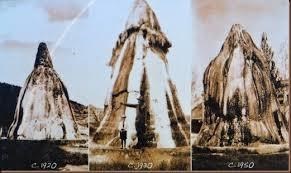Tourists visiting the town of Thermopolis (‘city of heat’), Wyoming (USA), are amazed by a monstrous rock mound in Hot Springs State Park. The mound dwarfs sightseers and many people would claim it looks immensely old. Astonishingly though, it is only young.
The mound began in 1903 when someone drove an iron pipe into the ground, allowing mineral-rich underground water to escape. Flowing out of the top of the pipe, the water released calcium carbonate mineral from solution and deposited it as travertine on every solid surface.
Within a few years, the travertine deposit had a huge base and tapered to a peak at the top of the pipe. The rock hung like pastel-coloured curtains and the locals called it Tepee Fountain. Today the mound is a little fatter and rounder than a tepee, and the water flow continues to this day.
Why does this rock deposit astound tourists so? People are surprised because the huge mound challenges their cultural conditioning. It contradicts what we have been led to expect about the age of rocks. People instinctively think of geological events such as petrifaction, fossilization and flowstone formation in terms of millions of years. When guides show us the stalactites and stalagmites in tourist caves, they tell us they took hundreds of thousands of years or more to form—drop by drop.
But the rock mound at Thermopolis proves it does not take vast amounts of time to form such objects. It just takes the right chemical environment. This gives us in miniature an example of the sorts of things that probably happened during the global Flood of Noah’s day. With lots of mineral-rich water flowing out of the ground causing layer upon layer of Travertine, it is not surprising that sedimentary rocks all over the earth—often thousands of metres thick—have turned into rock since the Flood, 4,500 years ago. Tepee Fountain illustrates that millions of years are not needed to produce solid rock.

How to log this Earthcache
Please email the CO your answers to the following questions.
Q1. - At GZ feel the minerial enriched water that is cascading over the Fountian. using your body temperature average of 97-99f (36-37c) What is the current temperature of the cascading water?
Q2. - What is the approximate height and width of the 'Fountian'
Q3. - As water flows over the rock, it cools and deposits layer upon layer of (What?)
Q4. - What Colors can you see on the rock today? How are the colors formed?
Go to the 2nd Waypoint. (Another formation similar to this one at GZ)
Q5. - What is the main difference between the two rock formations?
I hope you have enjoyed learning about this unique rock formation.